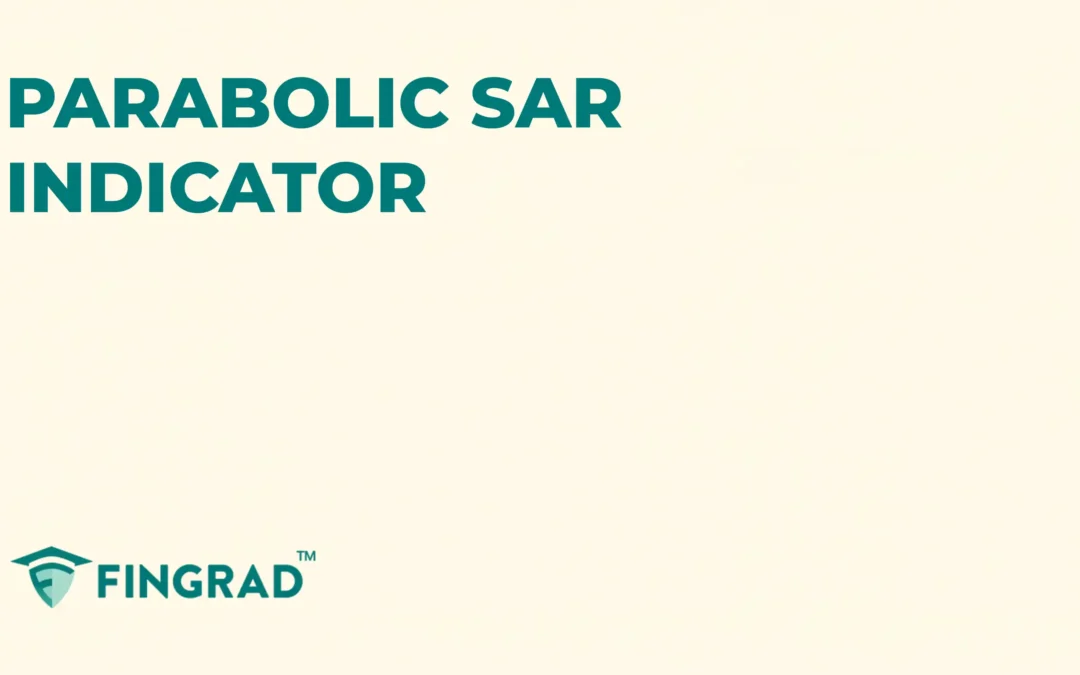In financial markets worldwide, charts reflect the price action, trend, and volatility of markets, which helps you understand the market and make better entry and exit points. The majority of the trading platforms provide you with indicators, where you can select and back-test your strategies and implement them in your trading.
In this article, we will understand the Parabolic SAR indicator, how it is calculated, how to trade it with an example, and its advantages and disadvantages.
What is the Parabolic SAR Indicator?
Parabolic SAR(Stop And Reverse) is a momentum indicator that appears as a series of dots either above or below the price action on a chart, indicating potential buy or sell signals, which in turn suggest a potential reversal and identify the upcoming trend.
- When the dot appears below the candlestick, it indicates a bullish buy signal.
- When the dot appears above the candlestick, it indicates a bearish sell signal.
Calculation
The formula for an uptrend:
SAR = Previous Period SAR + AF x (EP – Previous Period SAR)
The formula for downtrend:
SAR = Previous Period SAR – AF x (Previous Period SAR – EP)
Where,
- EP(Extreme Point): It represents the highest high reached in an uptrend. In a downtrend, it represents the lowest low reached.
- AF(Acceleration Factor): AF starts at 0.02 and increments by 0.02 each time an extreme point (EP) is reached, up to a maximum often set at 0.20.
- SAR(Stop and Reverse): The calculated value that is plotted as a dot on the chart.
How to trade the Parabolic SAR
Buy Signal
When the Parabolic SAR dot flips from above to below the price, this generates a buy signal, then it suggests an uptrend ahead
Entry:
- When the dot on the price chart flips from above to below the candlestick, this is a buy signal. Plan a trade as the bullish candlestick closes above the high of the first candlestick.
Stop-loss:
- The ideal stop-loss is at the Dot on the first candlestick, and as the price moves up, trail the stop-loss according to the next dot on the next candlestick.
Target:
- The initial target is the next resistance lineor based on your risk reward ratio.
- If there is a dot that appears above the candlestick, then take profit or trail the stop-loss.
Example Scenario: When you look at the image below, the chart of “ VEDANTA Ltd” stock at a 1-hour timeframe on 14th January 2025. The buy signal is generated by the Parabolic SAR followed by a bullish candlestick, indicating an uptrend ahead.
Sell Signal
When the Parabolic SAR dot flips from below to above the price, this generates a sell signal, then it suggests a downtrend ahead.
Entry:
- When the dot on the price chart flips from below to above the price, this is a buy signal. Plan the trade at the bearish candlestick that closes below the low of the first candlestick.
Stop-loss:
- The primary stop-loss is at the Dot on the first candlestick, and as the price moves down, trail the stop-loss according to the next dot on the next candlestick.
Target:
- The initial target is the next support line, or it can be according to your risk-reward ratio, 1:1, 1:2, or higher.
- If there is a dot that appears below the candlestick, then take profit or trail the stop-loss.
Example Scenario: When you look at the image below, the chart of “ Varun Beverages Ltd” stock at a 1-hour timeframe on 5th February 2025. The sell signal is generated by the Parabolic SAR followed by a bearish candlestick, indicating a downtrend ahead.
What are the advantages of Parabolic SAR?
- The Parabolic SAR provides you with a clear understanding of the Trend and identifies clear Entry and Exit Points.
- The Parabolic SAR provides trailing stop-loss, helping you hold the trade for higher targets, and it is versatile across all timeframes.
- The Parabolic SAR provides early Reversal signals of the trend according to the price action.
What are the Disadvantages of Parabolic SAR?
- The Parabolic SAR is a lagging Indicator due to its nature because it reacts to past price movement.
- It is not ideal for very short-term trading or scalping due to its lagging nature, as the dot flips often at the lower timeframes.
- In a sideways market, as the price is stuck between a small price range, due to a lack of volume, the indicator can result in a false signal.
- It indicates trend reversal but does not provide complete information on the strength of the trend.
In Closing
In the above article, we covered the Parabolic SAR indicator, how to trade, how to calculate it, with an example, and lastly, its advantages and disadvantages.
Parabolic SAR Indicator adapts quickly to the market price action, following it, indicating potential reversals, and making it more efficient. It indicates multiple opportunities for clear entry and exit signals, and with proper risk management, discipline can pave the path to profitability.
In all financial markets, no indicator or tool is 100% accurate when the Parabolic SAR is combined with additional tools like RSI, MACD, and trendlines, and the efficiency and accuracy increase rapidly.


